Make an Appointment
Running long distances is no easy feat. It’s not something you can just get up and do out of nowhere. It requires purposeful training to achieve. But, it’s not impossible - even if you’re an absolute beginner!
Here, we’re sharing our ultimate guide for long-distance running training for beginners. By going over the key areas you’ll need to develop to become a long-distance runner and giving you the rundown on training for both a 5K and 10K run, you’ll be running long distances in no time.
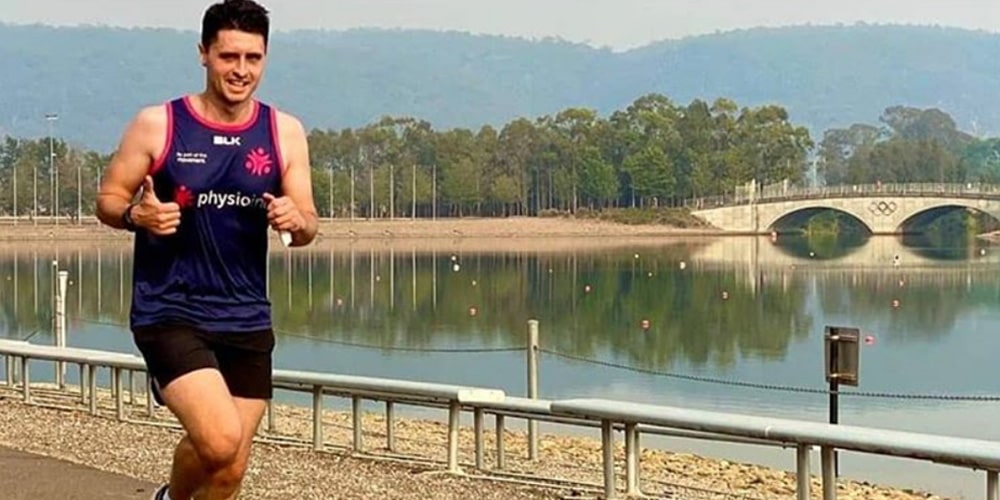
Start Running as a Beginner
To reach your potential as a distance runner, you need to develop these key areas:
- Endurance base
- Lactate threshold
- Maximum aerobic capacity - VO2 max
- Basic speed
- Running technique
If you’ve trained for a marathon, you probably only focused on improving your endurance base and paid little attention to the other four necessary training areas. But to improve your overall running performance, you should incorporate all of these components into your training schedule – in the balance that’s right for you.
Endurance Base
Your endurance base refers to how long you can run at a comfortable pace. Once you find your endurance base (and as a beginner perhaps this is only about five minutes at a time), it can help you build from there.
On an easy day, you might only run for 10 minutes before switching to a walk, then on a hard day pushing yourself to run for 20 minutes straight. This increases your endurance base.
Lactate Threshold
Your lactate threshold is similar to your endurance base. It refers to how long you can run before you feel a buildup in lactate. Lactate is what makes your muscles cramp and feel sore the next day.
Understanding how much you can take before this buildup becomes too much is your lactate threshold. It will also gradually increase with proper training.
Maximum Aerobic Capacity
Your maximum aerobic capacity measures the ability of your heart and lungs to send oxygen to your muscles. Again, understanding your maximum cardio capacity can help you identify where you’ve started so that you can slowly and steadily increase your running distances.
Basic Speed
Additionally, knowing your basic speed can help when figuring out your starting point as a beginner to running. Your basic speed is how fast you can run while continuing to hold a conversation. As you build stamina, you’ll see your basic speed start to increase.
Running Technique
Your running technique is essential for gaining the most speed and endurance possible. By using the correct form, you’re not expending any unnecessary energy, therefore, channeling everything you’ve got into the run itself.
Correct Running Form:
- Keep your spine upright with your head, shoulders, and hips aligned.
- Focus on your breath, keeping a steady rhythm.
- Follow through on your strides versus cutting your movements short.
- Find your natural stride, either leading with the heel or running toe to heel.
To find your ultimate running form, meet with an exercise physiologist for assistance.
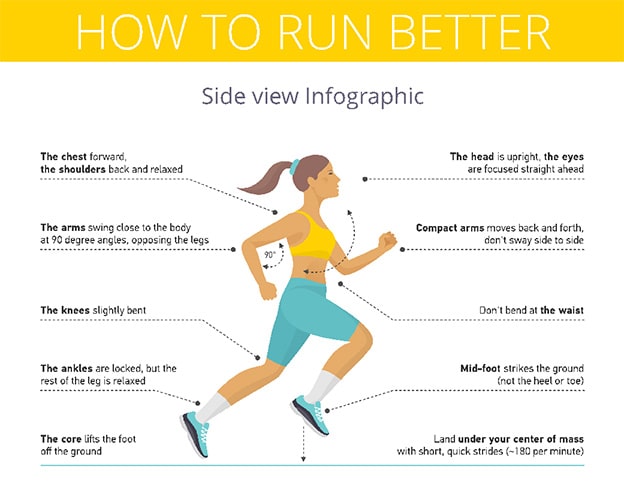
Think Long-Term
Your body adapts to the stress of training slowly and over a period of time. Physiological adaptations can’t be rushed, although you can design your training to optimise the process.
Adaptations in your muscles occur over months and years and you need to think long term. The minimum time before you ’ll start to see an improvement from training is about six weeks.
Increase Gradually
Your training load is a combination of your training distance, intensity, and how many runs you do each week. Your body can only develop in line with moderate increases in training load if you keep increasing the load during a short period of time.
For instance, over a few years you can double or even triple your running distance, but increasing it too much and too quickly leads to injury, illness and over-tiredness. Therefore, it’s best to limit changes in your distance, intensity or frequency to no more than once a week.
Recovery
Sometimes, running beginners train hard every day trying to cover all the components of their training program. This is a common mistake and will slow down your progress. Rest days are essential to allow the body to develop, adapt, and speed up your progress.
When you train hard you provide the stimulus to improved fitness, but your body needs recovery time to focus its energy on growing and adapting. This is why the classic training pattern is to alternate a hard training day with an easy day or a rest day. You can do two consecutive hard training days if you follow with at least two full recovery day.
Believe me, I could tell you many a tale about those who’ve over-trained and ended up with an injury, extreme fatigue and loss of motivation - the opposite of what they set out to do!
So take a sensible approach to your training and treat your body with respect and it’ll reward you well!
Step-by-Step Running Training Guides for Beginners
We get it. That was a lot of information. But how can we put it into practice? Our exercise physiologists at Physio Inq have put together this generalised training guide for beginners who want to learn how to run long distances.
How to Train for a 5K Run
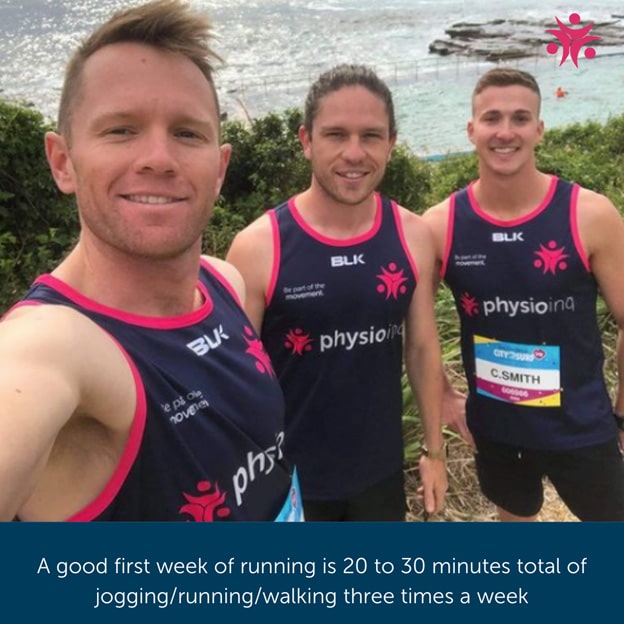
For beginners, the best place to start is by completing a 5K run. Sign up for a 5K race in your local area to give yourself a deadline to shoot for. These events usually attract both beginner and more advanced runners, making it a solid choice for any skill level.
This 5K run training program for beginners builds on the principles discussed above. It requires that you’ll run for 30 minutes two days per week and you’ll run for longer distances once per week.
All in all, to complete this training program, you’ll need about seven weeks.
A note on Run/Walk Method: Developed by Olympian Jeff Galloway, the run/walk method should be executed by switching to a walk when you’re not yet tired instead of slowing to a walk when you’re too tired during your run.
The idea is to train your cardiovascular system to recover more quickly by taking short breaks in between more strenuous exercise. It helps to improve your overall endurance in long-distance runs.
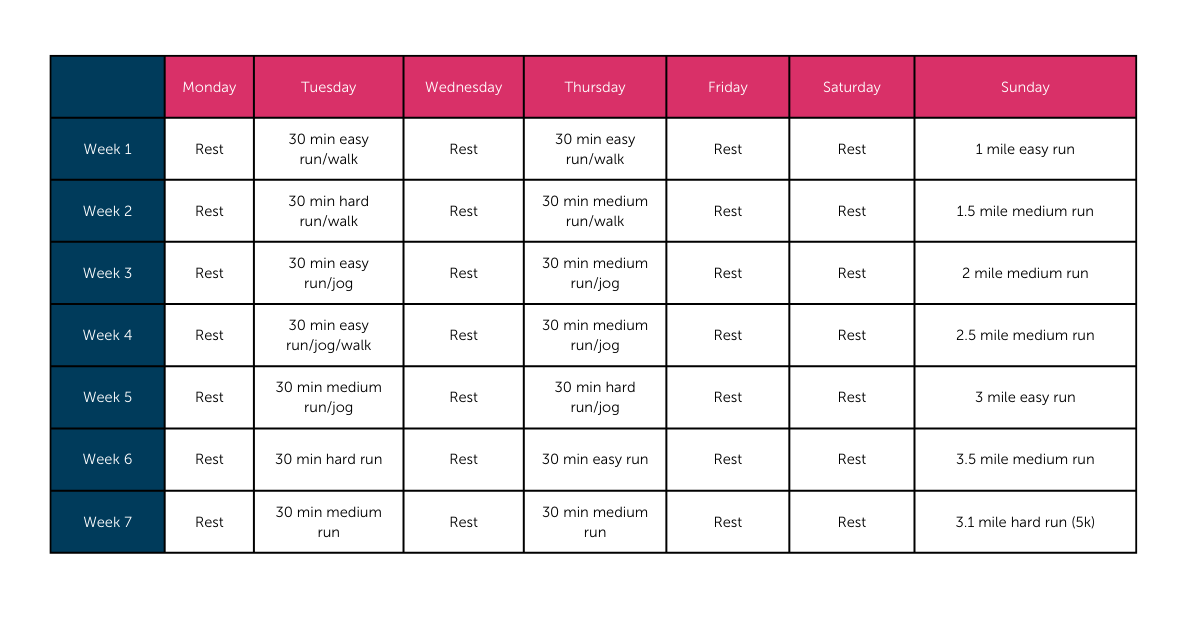
This running training plan for beginners is simply an outline. Depending on your fitness levels and overall health, these recommendations will vary.
For the best results, book an appointment with a Physio Inq exercise physiotherapist to help you create a custom running training plan for your level.
How to Train for a 10K Run
When training for a 10K run, beginners should start with a 5K race. Once that’s been completed, you can build up to a 10K training plan.
However, if you’re starting from scratch in preparing for a 10K race, this 10-week program can get you off to a solid start.
You’ll need to be running about three days per week with longer runs once a week. It’s also smart to incorporate hill runs when training for a 10K as an absolute beginner.
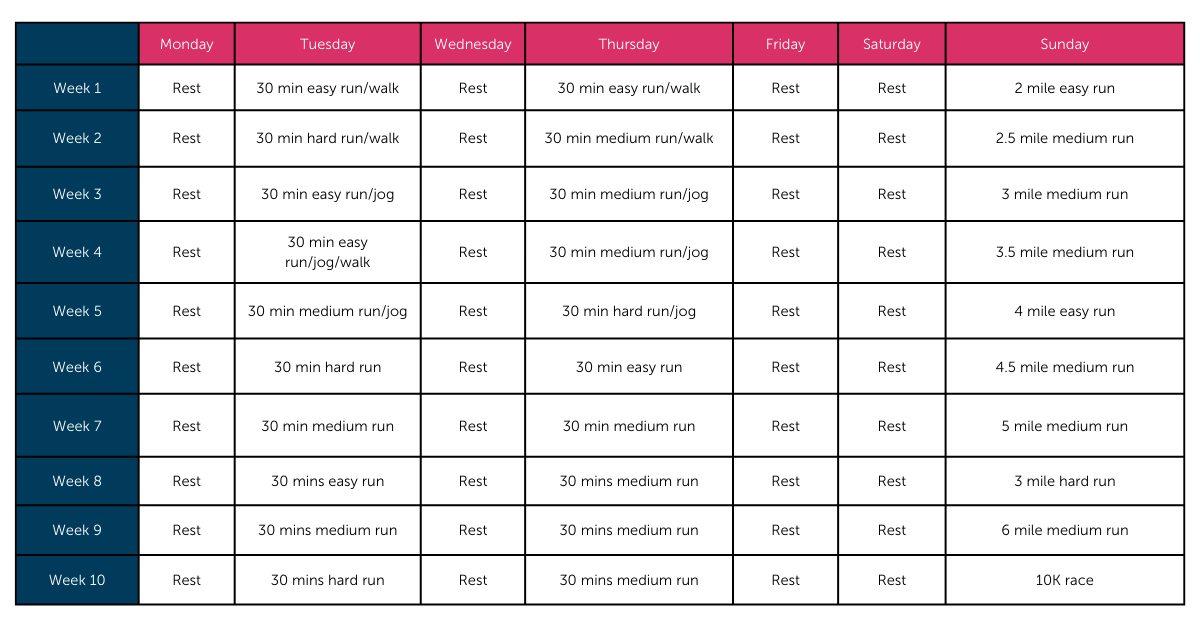
Again, this beginners’ 10K training program is a generalised guide. For a personalised running training program, it’s always best to consult with a professional.
Book an appointment with one of our exercise physiologists today for a custom training plan to take you from beginner to marathon runner. Contact Physio Inq today.
Date Published: Monday, December 14, 2020
Date Modified: Tuesday, July 2, 2024
Need to get into direct contact with ur Client Services team? We're all ears. Call our team directly on 1300 731 733
